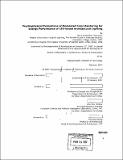Psychophysical evaluations of modulated color rendering for energy performance of LED-based architectural lighting
Author(s)
Thompson, Maria do Rosário
DownloadFull printable version (21.93Mb)
Other Contributors
Massachusetts Institute of Technology. Dept. of Architecture.
Advisor
Terry Knight and Una-May O'Reilly.
Terms of use
Metadata
Show full item recordAbstract
This thesis is focused on the visual perception evaluation of colors within an environment of a highly automated lighting control strategy. Digitally controlled lighting systems equipped with light emitting diodes, LEDs, can produce a range of different qualities of light, adjustable to users' requirements. In this context of unparalleled controllability, a novel energy-saving lighting control concept inspired this research: strategic control of Red, Yellow, Green & Blue LEDs forming white light can further increase energy efficiency. The resulting (more efficient) white light, however, would have decreased "color rendering" (i.e. the ability of accurately reproduce the colors of illuminated objects). The notable point is that while color rendering is necessarily affected, the appearance and light levels of the white light can stay the same. But how objects' distorted colors are perceived within a real life architectural context is a key, ensuing question. This research investigated the hypothesis that a significant range of color distortions would be unnoticeable under a dynamically controlled LED system, when operating outside of users' main field of view. If successful, such control technique could minimize peak hours lighting energy waste, and potentially enable up to 25% of power reduction. (cont.) Three incremental series of psychophysical experiments were performed based on subjective assessment of color changes under continuously modulated color rendering from white LEDs. Visual tests were carried out for central and peripheral vision on a full scale mockup of an architectural scenario. Results confirmed the fundamental hypothesis, showing that the majority of subjects did not detect the color changes in their periphery while the same color changes were noticeable with direct observation. The conclusion chapter provides fundamental guidelines for how to extrapolate the experimental results into real life and apply the data to architectural settings. Hypothetical architectural scenarios are presented and the potential for energy savings is discussed.
Description
Thesis (Ph. D.)--Massachusetts Institute of Technology, Dept. of Architecture, 2007. Includes bibliographical references (p. 137-146).
Date issued
2007Department
Massachusetts Institute of Technology. Department of ArchitecturePublisher
Massachusetts Institute of Technology
Keywords
Architecture.